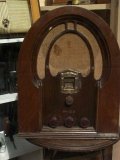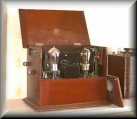Marking criteria
You are expected to devote all your working week to this course - [FILL THIS NUMBER IN} hours a week.
Some of the hours remaining from our teaching time together [TO THE AMOUNT OF - FILL IN THIS NUMBER]
are to be spent in your own work on your projects, group work, and in private study.
You must devote this amount of time to your work on this module if you are to achieve the objectives of this course.
| Marking for radio practical work is on (all radio work) - on this page |
| Marking for radio drama work (on this page) |
Marking for radio practical work is on (all
radio genres):
| key radio/journalistic skills | depth of understanding |
| clear writing | team working and communicating with teacher |
| technical strength | ability to communicate via the product |
| voicing | research, identifying the brief and its needs |
| use of genre | originality- shedding new light, moving in an original way |
| selection of audio clips and effects | |
| directing | management of studio and post-production |
| accounting for project in STUDENT CRITIQUE | management elements in the course communication with practitioners, peers and teachers |
| working for broadcast and for laboratory product | |
| You must account for copyright | |
| comprehending instructions from teacher | |
|
|
|
Marking for radio drama work is on the following
| NOTE: The full list of techniques and suggested creativity for a radio drama director is on this site and in the book 'Radio Acting' (Alan Beck). |
| Originality and creatively working with established strands and protocols of radio drama (mostly on the B.B.C.) (if appropriate) OR creativity in laboratory work (not within the protocols of B.B.C. radio drama and not for broadcast) - See BBC Editorial Guidelines - links and excerpts |
creativity overall in the piece - shedding new light, moving in an original way, working experimentally (if appropriate) - as filmic radio drama directing, hyper-realism, 'scratch' etc. |
| deploying creatively all the appropriate range of techniques for radio drama (either 'standard production' or more adventurous and experimental) - dialogue, FXs, music, wild-track, silences, atmos, voices in the appropriate acoustic of the scene, sign-posting, creating the location for the scene and the whole 'mise en scène', movement of characters in the scene (5 positions to the microphone), hook, description, address, naming, establishing presence, economy rule, avoiding clustering, protagonist-dominated (if appropriate), montage (if appropriate) |
| deploying creative structure and protocols of narrative - construction of scenes, protagonist-dominated (if appropriate), opening of scene; hook, signposting, establishing presence, closure of scene, closure of piece, design of each scene in the whole product, use of scene boundaries and creative use of these in the whole product (Archers fade, cross-fading, straight cut, lightning cut, etc.) |
| technical strength - production; post-production; balancing FXs, music and dialogue against each other; avoiding blasting and popping; creating the appropriate location ('mise en scène') for each scene; appropriate use of the neutral acoustic for a scene in the whole; design of each scene in the whole product; use of scene boundaries and creative use of these in the whole product (Archers fade, cross-fading, straight cut, lightning cut, etc.) |
| directing actors (appropriate auditioning and casting, expressive and fulfilling acting) and the production team |
| team working and communicating with teacher |
| use of genre (as thriller, vampire, realist drama, sci-fi, drama-documentary etc.) - see list |
| depth of understanding |
| ability to communicate via the product |
| sense of audience for the product |
| research, fulfilling the text and its needs |
| clear and communicative writing for radio, adapting for radio drama script, original writing for radio drama |
| selection of audio clips and effects - showing range and creativity, and avoiding clichés |
| Choice of music and FXs - showing range and creativity, and avoiding clichés |
| as producer - the business side of the production - management of studio, auditions and casting, business side of working with actors, business of post-production, presentation of final product for marking (critique appropriately presented and organised, 2CDs labelled, timings given - see rules in CRITIQUE), management elements in the course - communication with practitioners, peers and teacher(s), publicizing the product (if appropriate), accounting for copyright (does not apply to laboratory work) |
| written critique - see rules in CRITIQUE |
| comprehending instructions or advice from teacher |
| knowledge of and creative use of radio protocols and conventions, and if relevant of those of a particular radio station and/or of a particular genre |
NOTE: Please buy a permanent marking pen, for you to label CDs correctly (name of project, your name, length of piece).
Some other useful links
| TALENT RELEASE FORM (INTERNET) |
| Location Release Form (internet) |
| BBC Editorial Guidelines |
|
|



